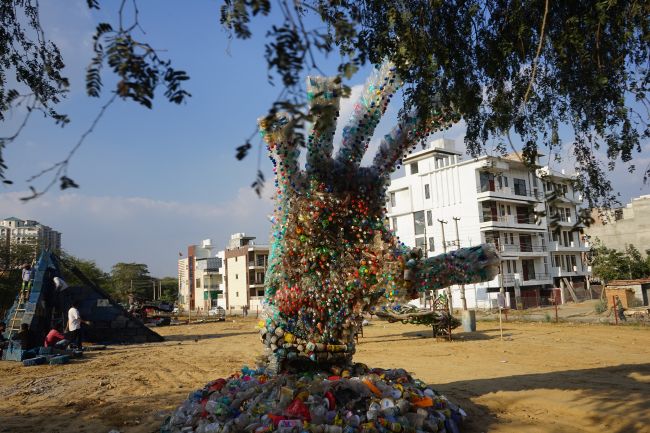New Delhi: ‘Are we creating cities of waste?’ With this question in mind, IAmGurgaon, an initiative aimed at awakening a responsible, aware and vigilant populace in order to make Gurgaon (now Gurugram) a better place to live in along with Municipal Corporation of Gurgaon and ArtPilgrim Live, an art gallery in the city, initiated ‘Where does it go?’. The campaign titled ‘Where does it go?’ focusses on building awareness around the growing mountain of waste and how it is impacting us and our environment through the medium of art.
Also Read: The Plastic Mess: Annual Plastic Waste Generation In India Much More Than It Reports, States CPCB
As part of the initiative, Wazirabad Bundh in Sector 43 of Gurugram was selected to be renovated. Once a barren land, now hosts 11 immersive sculptures made using different kinds of waste including plastic bags, PET bottles, cans, discarded plastic containers, and e-waste like CDs, over a period of 10 days.
Talking to NDTV about the initiative, Nidhi Kankan, volunteer at IAmGurgaon says,
We tend to throw everything once it is of no use to us. Finished a packet of chips? Toss it in the bin. Have an empty PET bottle? Put it in the garbage. We throw bit by bit and don’t realise the amount of plastic waste we generate in a day, week or month. The initiative aims at showing people the mirror.
Also Read: Garbage Dump Turned In To A Biodiverse Park To Keep City Clean Under ‘IAmGurgaon’ Campaign
Arun Kumar HG, a renowned artist along with 12 local artists, participated in the waste management and awareness activity. Each of the art installations communicates a message on the impact of waste we generate, and the need to segregate waste.
For instance, ‘the toxic chamber’, a large cave like structure, created by artist Arun Kumar, is a functional space that allows people to experience, observe and feel the waste that they have generated. It is made to make people realise the amount of plastic waste they generate intentionally or unintentionally.
According to Arun Kumar, the waste used in making the toxic chamber could be one person’s usage in five years. A walk inside the toxic chamber is an eye-opener for people, and gives out the message that they need to change their habits, soon, says Gayatri Singh, Director at ArtPilgrim Live.
Also Read: Goodbye Plastic, Hello Creativity: Five Easy Ways To Reuse Plastic Bottles
While a ‘waste detector’ which is basically a garbage man with a detector in his hand created by Pinaki R Mohanty, one of the artists brings attention to the importance of waste segregation and reducing the waste load on landfills, ‘steal the treasure of nature’ – a giant hand of plastic established right next to a tree, by Ramkumar Kannadasn, depicts plastics suffocating tree and taking over greenery.
On the other hand, ‘left over’, one of the art installations portrays a fish that has died due to plastic and all that is left is plastic. The art shows how plastic is threatening the lives of both humans and animals.
Also Read: Bid Adieu To Plastic Straws And Give Them A Creative And Useful Makeover
While talking about turning the concept of educating through the medium of art into reality, Nidhi Kankan says,
Waste has played a major part in giving life to our idea. For the same, we sourced plastic waste and scrap from 10 resident welfare associations (RWAs), 14 schools and four private offices. We managed to collect 11.5 tonnes of different kinds of waste including plastic, iron, metal, and e-waste.
The place is now known as Samadhaan (solution) hub, mainly because apart from hosting varied art installations, the place holds awareness sessions and workshops on different kinds of waste, waste segregation, and composting.
The idea is simply to create a space where people can come and donate waste and learn new things. Ours is a step in that direction, signs off Nidhi.
Also Read: United Nations General Assembly President Praises India’s War On Plastic Pollution
NDTV – Dettol Banega Swachh India campaign lends support to the Government of India’s Swachh Bharat Mission (SBM). Helmed by Campaign Ambassador Amitabh Bachchan, the campaign aims to spread awareness about hygiene and sanitation, the importance of building toilets and making India open defecation free (ODF) by October 2019, a target set by Prime Minister Narendra Modi, when he launched Swachh Bharat Abhiyan in 2014. Over the years, the campaign has widened its scope to cover issues like air pollution, waste management, plastic ban, manual scavenging and menstrual hygiene. The campaign has also focused extensively on marine pollution, clean Ganga Project and rejuvenation of Yamuna, two of India’s major river bodies.

































